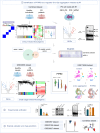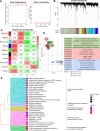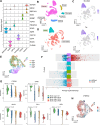Protein tyrosine phosphatase receptor type O serves as a key regulator of insulin resistance-induced α-synuclein aggregation in Parkinson's disease
- PMID: 39276174
- PMCID: PMC11401831
- DOI: 10.1007/s00018-024-05436-4
Protein tyrosine phosphatase receptor type O serves as a key regulator of insulin resistance-induced α-synuclein aggregation in Parkinson's disease
Abstract
Insulin resistance (IR) was found to be a critical element in the pathogenesis of Parkinson's disease (PD), facilitating abnormal α-synuclein (α-Syn) aggregation in neurons and thus promoting PD development. However, how IR contributes to abnormal α-Syn aggregation remains ill-defined. Here, we analyzed six PD postmortem brain transcriptome datasets to reveal module genes implicated in IR-mediated α-Syn aggregation. In addition, we induced IR in cultured dopaminergic (DA) neurons overexpressing α-Syn to identify IR-modulated differentially expressed genes (DEGs). Integrated analysis of data from PD patients and cultured neurons revealed 226 genes involved in α-Syn aggregation under IR conditions, of which 53 exhibited differential expression between PD patients and controls. Subsequently, we conducted an integrated analysis of the 53 IR-modulated genes employing transcriptome data from PD patients with different Braak stages and DA neuron subclasses with varying α-Syn aggregation scores. Protein tyrosine phosphatase receptor type O (PTPRO) was identified to be closely associated with PD progression and α-Syn aggregation. Experimental validation in a cultured PD cell model confirmed that both mRNA and protein of PTPRO were reduced under IR conditions, and the downregulation of PTPRO significantly facilitated α-Syn aggregation and cell death. Collectively, our findings identified PTPRO as a key regulator in IR-mediated α-Syn aggregation and uncovered its prospective utility as a therapeutic target in PD patients with IR.
Keywords: Dopaminergic neurons; Insulin resistance; PTPRO; Parkinson’s disease; α-Synuclein aggregation.
© 2024. The Author(s).
Conflict of interest statement
The authors declare no conflict of interest.
Figures









References
-
- Mieczkowski J, Kocyk M, Nauman P, Gabrusiewicz K, Sielska M, Przanowski P et al (2015) Down-regulation of IKKβ expression in glioma-infiltrating microglia/macrophages is associated with defective inflammatory/immune gene responses in glioblastoma. Oncotarget 6:33077–33090 10.18632/oncotarget.5310 - DOI - PMC - PubMed
MeSH terms
Substances
Grants and funding
- 2021GXRC029/Jinan Science and Technology Bureau
- 2022JC019/Fundamental Research Funds for the Central Universities
- 82273195/National Natural Science Foundation of China
- 82273286/National Natural Science Foundation of China
- 82201402/National Natural Science Foundation of China
- tsqn202211316/Youth Taishan Scholar Program of Shandong Province
- tspd20210322/Taishan Pandeng Scholar Program of Shandong Province
- ZR2022MH313/Natural Science Foundation of Shandong Province
- ZR2023QH240/Natural Science Foundation of Shandong Province
- ZR2023LZL004/Natural Science Foundation of Shandong Province
- 2022KJ011/Shandong Province Youth Innovation Plan
- 2021ZD0201600/Science and Technology Innovation Major Project, Ministry of Science and Technology of China
- 2022TQ0196/China Postdoctoral Science Foundation
- SDCX-ZG-202302028/Shandong Postdoctoral Science Foundation
LinkOut - more resources
Full Text Sources
Medical
Molecular Biology Databases
Miscellaneous

